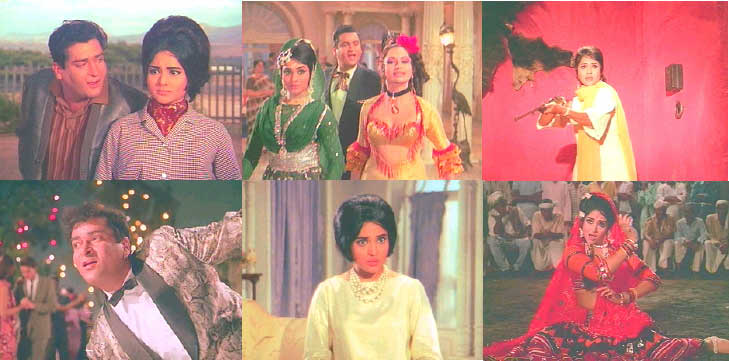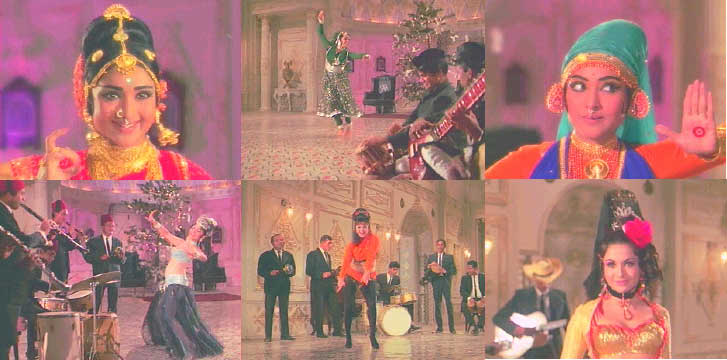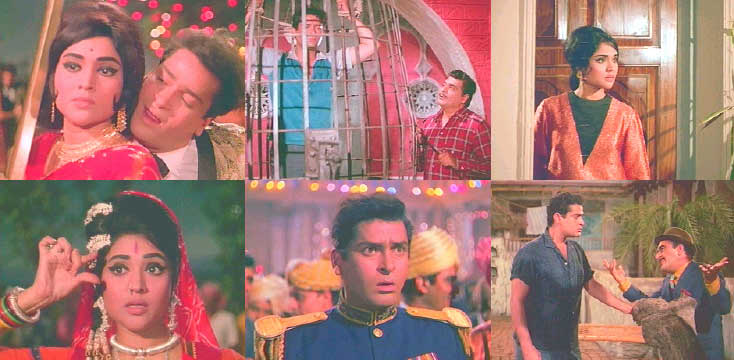Prince

Director: Lekh Tandon
Music: Shanker-Jaikishan; Lyrics:Hasrat/Faruk
Kaiser
Year: 1969
Running Time: 2 hrs 37 minutes
It’s good to be a Prince. Probably any Prince
would do really. Just having people address you as Prince would be kind of
fun for a while though over time perhaps it would get a bit dreary. For Prince
Shamsher it has indeed gotten very dreary and boring and it is all he can
do to motivate himself to chew on his food. As the Prince, Shammi Kapoor
is quite wonderful – he is like a gorged tick after a Thanksgiving dinner
– his face bathed in indifference, his eyes as lifeless as two beans in a
pudding and his hefty slovenly body firmly anchored by gravity to the ground.
A beautiful woman adorned in sparkling bangles dances for him, but it is
all he can do to keep his eyelids upright as he pops pills and complains
about everything. After India became independent in 1947, there were a number
of small kingdoms that did not immediately become integrated into the country,
but remained somewhat autonomous for a few years. Shamsher (Shammi’s real
name by the way) and his father are rulers in one of these regions living
in an ornate palace with enough servants to populate a small country.

One day this all begins to change when he comes across a holy man who refuses
to bow to his will and Shamsher whips him in a frenzy and then collapses
in guilt and remorse. The holy man tells him that to become a man again he
needs to throw off his princely possessions and go out and live as a normal
person for six months. Shamsher takes this to heart and thus begins a light
but very enjoyable Capraesque tale of a rich man pretending to be poor falling
in love with a rich girl and finding his humanity again. He stages an accident
in which it looks like he has died and he goes on the road. He soon gets
a ride from an insurance salesman (Rajindernath who seems to show up in many
of Shammi’s films as the comical sidekick) and they come across a gaggle
of supposed village girls – but who are in fact very upper class – looking
for a ride. One of these is Vyjayanthimala who breaks into a song in order
to gain passage. After letting off the girls, the two men are attacked by
dacoits (bandits) and Shamsher is held hostage – but one of the dacoits frees
him because he wants to leave the gang and visit his ailing blind mother
(Leela Chitnis). On the way though the dacoit is killed, but before his dying
Shamsher promises to go see his mother.

Like all good Indian mothers, she is devoted to her long-gone son – but unlike
most Indian mothers she can’t apparently recall his voice and so immediately
assumes Shamsher is her son and he realizes that to tell her the truth would
kill her. So he goes along with this and picks up the loving mom he never
had. He also gets a job working in the stables of the King (Sapru) of this
small region – and just as you would expect if you have seen many Bollywood
films, the Princess turns out to be the girl he met on the road – and she
takes an immediate dislike to this overly friendly commoner. She is as arrogant
as he once was and Shamsher starts a charm campaign to wear her down showing
his skills at polo, skiing, dancing and singing (“Oh haughty one, I’m bowled
over”).

This leads to one of the best dance sequences you will come across as her
friend from Europe comes to visit – played by the legendary Helen – and they
decide to show this fellow how to dance and put on a bravura display of classical
and modern dance that will make your toes curl. Things get much more complicated
later on as Shamsher has to fight for his birthright against the always evil
Ajit, take on more dacoits, escape certain death, get tortured and keep his
weight down. It is great fun with Shammi going back and forth between his
commoner and Prince personas as adroitly as he dances. There are some amusing
scenes as well – one bedroom farce sequence in which he ends up in the wedding
bed of his father and then gets physically attached to the Princess are terrific.

Though Vyjayanthimala looks to be in her mid-twenties in this film, she was
actually reaching her mid-thirties and near the end of her career. In 1970
she was to marry the physician of Raj Kapoor and retire from film. She had
an amazing career that began in the early 1950’s at the age of fifteen and
was one of the first South Indian actresses to make it big in Bollywood.
She was also one of the great dancers of her time and her popularity made
it mandatory for actresses to obtain this skill. She specialized particularly
in classical Indian dance and has stunning footwork and form that is well
displayed in Prince. Her first huge success was the 1954 Nagin, but it was
her role as the tragic Chandramukhi in the 1955 version of Devdas that made
people notice that she was a fine actress as well as a great dancer. Some
of her other classic performances were in Sadhana in which she played a prostitute,
Ganga Jamuna as a washer woman, Jewel Thief in which she pairs up with Dev
Anand and Amrapali in which she again plays a courtesan. Though she retired
from film, she continued to perform her classical dances on stage and still
does at this time. Prince also marked the near end of Shammi as a popular
leading man in Indian films. In the same year a film called Aradhana came
out to acclaim and ushered in the era of Rajesh Khanna and a new series of
heroes. Nearing his forties and fast losing the fight with his girth, Shammi
became more of a character actor over the next ten years. In the sixties
though no one was more fun to watch than Shammi. There are only two male
Indian actors who I want to see everything they made - Shahrukh Khan and
Shammi.

As expected with a score from Shanker-Jaikishan, the music is a highlight
of the film. It also has the three legendary voices of Lata, Asha and Mohd.
Rafi doing the vocals and it is a treat. The music jumps from genre to genre
with ease as we get a little bit of everything from classical to pop to latin
and even an Egyptian rhythm tossed in. There are six songs of which two are
particular standouts. One is the before mentioned "Muqabla humse na" in which
Vyjayanthimala and Helen put on a tour de force of dance form as they each
have three costume changes to signify a different kind of dance style. "Badan
pe sitare" is a romantic torcher in which Shammi begins to break down the
Princess’s cool demeanor on the dance floor with lyrics like “With the stars
adorning your whole body; Where are you headed O’ Sweetheart; If you could
come closer to me; I would find so much peace”. The final song "Bachke
jaane na" is another opportunity to just watch Vyjayanthimala dance as the
two of them have escaped from the dacoits and take on the disguise of two
vagabond entertainers and have to perform for a small village.

My rating for this film: 7.5







